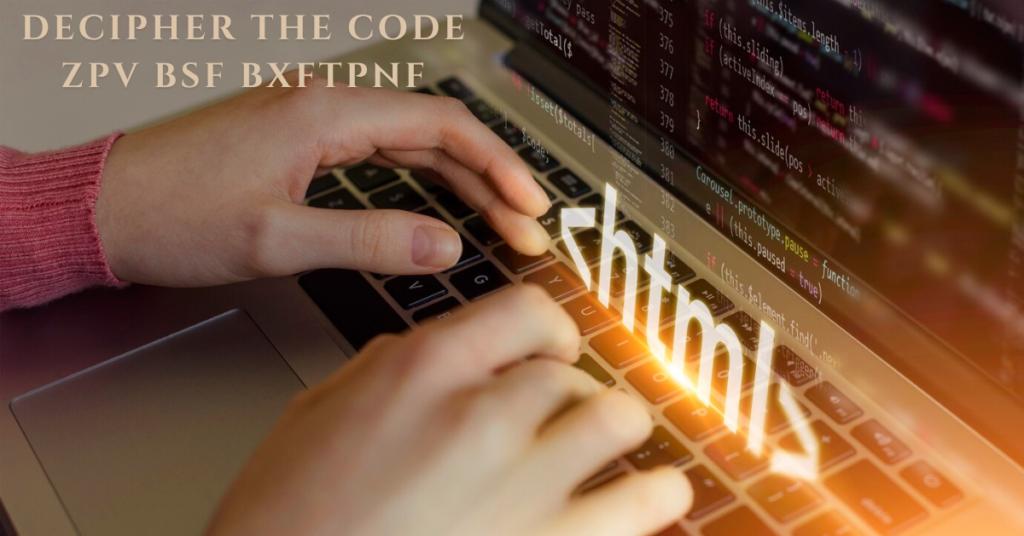Cryptography has a way of captivating our imagination by transforming everyday words into intriguing puzzles. One such puzzle is “decipher the code zpv bsf bxftpnf.” At first glance, it might appear to be a random jumble of letters, but with the right approach, this code reveals an uplifting message: “YOU ARE AWESOME.” In this article, we’ll explore the art of cryptography, take you on a step-by-step journey through the decoding process, and delve into the hidden secrets that lie behind simple ciphers. Along the way, you’ll discover how deciphering the code zpv bsf bxftpnf not only sharpens your mind but also connects you to a rich history of encrypted communication.
Introduction
Cryptography isn’t just about secret messages reserved for spies or tech geniuses. It’s a playful, engaging tool that allows anyone to hide and reveal messages in plain sight. Have you ever stumbled upon a code that made you pause and wonder what hidden secrets it might hold? The excitement of decoding a message is like uncovering a piece of a hidden treasure map.
Overview of the Mystery
The phrase “ZPV BSF BXFTPNF” might seem mysterious at first, but once you start peeling away its layers, it reveals a message of encouragement and positivity. This article will serve as your guide to understanding how simple substitution ciphers work, particularly focusing on this specific code, and will inspire you to explore the world of hidden messages on your own.
Importance of Cryptography in Everyday Life
Beyond puzzles and secret messages, cryptography plays a crucial role in protecting our digital world. From securing online banking transactions to ensuring private communications remain confidential, the principles behind “decipher the code zpv bsf bxftpnf” extend far beyond recreational brain teasers. Understanding these basics can empower you to appreciate the security measures that protect sensitive information every day.
Understanding Cryptography
To truly appreciate the elegance behind a message like “ZPV BSF BXFTPNF,” we must first dive into the world of cryptography. Cryptography is the study of techniques for secure communication, and it has been used throughout history to protect secrets.
What is a Cipher?
A cipher is essentially a method of transforming text to hide its original meaning. Think of it like a secret language that only those in the know can understand. In the simplest terms, it’s a tool that shifts, substitutes, or jumbles letters to create an encoded message.
Common Types of Ciphers
There are several types of ciphers, each with its own method of encrypting a message. Some common ciphers include:
- Substitution Ciphers: Where each letter in the plaintext is replaced by another letter.
- Transposition Ciphers: Where the letters are rearranged according to a certain system.
- Polyalphabetic Ciphers: Which use multiple alphabets to encrypt the message, adding another layer of complexity.
The Role of the Caesar Cipher
One of the most famous and simplest ciphers is the Caesar cipher. Named after Julius Caesar, this method involves shifting the alphabet by a certain number of places. In many cases, including our featured code, the shift is just one letter. By shifting every letter in the phrase “ZPV BSF BXFTPNF” one step back in the alphabet, you reveal the encouraging phrase “YOU ARE AWESOME.”
Decoding the Message
Now, let’s roll up our sleeves and walk through the process of deciphering the code. By examining the structure of “ZPV BSF BXFTPNF,” we can understand how this message is crafted and how you can use similar techniques to decode other messages.
Step-by-Step Decoding Process
- Identify the Cipher:
When you see an unusual string of letters, your first step is to consider common ciphers. In this case, the structure suggests a simple substitution, likely a Caesar cipher. - Determine the Shift:
Look for patterns. The sequence “ZPV” is a clue. If you consider that it might decode to “YOU,” you can deduce that each letter has been shifted by one position. Z shifts back to Y, P to O, and V to U. - Apply the Shift:
Continue this process for the entire code. For “BSF,” shifting each letter back by one gives B→A, S→R, F→E, forming “ARE.”
Similarly, “BXFTPNF” becomes: B→A, X→W, F→E, T→S, P→O, N→M, F→E, resulting in “AWESOME.” - Review and Confirm:
Once you’ve applied the shift, read the message as a whole to ensure it makes sense. In our case, the complete phrase is “YOU ARE AWESOME.”
Analyzing the Code: “ZPV BSF BXFTPNF”
What makes this cipher interesting is its simplicity. A one-letter shift, a hallmark of the Caesar cipher, hides a message in plain sight. The code “decipher the code zpv bsf bxftpnf” becomes a fun exercise in pattern recognition and a reminder of the subtle art of encryption.
Revealing the Hidden Message
After applying the simple shift, you uncover an encouraging message: “YOU ARE AWESOME.” This hidden message is a testament to how even the simplest cryptographic techniques can be used to convey deep, meaningful sentiments in a playful and engaging manner.
Historical Context and Relevance
Cryptography has a long and fascinating history that spans from ancient times to the modern digital era. By understanding its evolution, we can better appreciate how simple ciphers like “ZPV BSF BXFTPNF” fit into a broader narrative of secret communication.
Famous Historical Ciphers
Historically, many renowned ciphers have been used to protect state secrets and military strategies. For instance:
- The Caesar Cipher: Widely used in ancient Rome.
- The Vigenère Cipher: Known as the “le chiffre indéchiffrable” (the indecipherable cipher) in its time.
- Enigma Machine: Used by Germany during World War II to encrypt military communications.
Each of these ciphers represents a stepping stone in the development of cryptography, showcasing the evolution from simple letter shifts to complex, machine-based encryption methods.
Evolution of Encryption Techniques
From the rudimentary substitution methods of the past to today’s sophisticated algorithms, the art of encryption has continuously evolved. Modern cryptographic techniques use complex mathematical principles to secure data, but the underlying idea remains the same: to transform information into a format that is unreadable without the proper key. The simplicity of “decipher the code zpv bsf bxftpnf” reminds us of where it all began, highlighting the ingenuity and creative spirit behind early encryption methods.
Modern Cryptography and Its Applications
In today’s digital age, cryptography is more important than ever. It serves as the backbone of secure communications, safeguarding everything from personal emails to international financial transactions.
Cybersecurity and Data Protection
Every time you shop online, send a message, or access your bank account, cryptography is working behind the scenes to protect your data. Encryption algorithms ensure that sensitive information remains private and secure. The same principles that allow us to “decipher the code zpv bsf bxftpnf” on a fun level also underpin the security of modern digital communications.
Cryptography in Everyday Communication
Beyond its technical applications, cryptography influences the way we communicate daily. Social media platforms, messaging apps, and email services all utilize encryption to maintain user privacy. Even a playful code like “ZPV BSF BXFTPNF” echoes this tradition by demonstrating how simple encryption can be both entertaining and meaningful.
The Psychological Aspect of Puzzles
Engaging with ciphers and puzzles is not only fun—it also has significant cognitive benefits. Solving puzzles like the code “ZPV BSF BXFTPNF” can boost your brainpower and improve your problem-solving skills.
Problem Solving and Critical Thinking
When you approach a cryptographic puzzle, you’re engaging in a process that sharpens your analytical skills. You must recognize patterns, hypothesize possible solutions, and test your ideas—much like a scientist conducting an experiment. This exercise in critical thinking is not just mentally stimulating; it also enhances your ability to tackle challenges in everyday life.
How Puzzles Enhance Cognitive Skills
Puzzles force your brain to work in creative ways, building connections between seemingly unrelated pieces of information. The challenge of “decipher the code zpv bsf bxftpnf” can help develop skills such as:
- Attention to Detail: Spotting subtle shifts in letters and patterns.
- Logical Reasoning: Deducing the rules that govern the cipher.
- Memory Enhancement: Recalling cryptographic techniques and historical contexts.
These cognitive benefits make puzzles a powerful tool for personal development and lifelong learning.
Unlocking Hidden Secrets Beyond the Code
While the immediate message of “ZPV BSF BXFTPNF” is uplifting, there’s a deeper layer to the art of decryption. Hidden secrets aren’t limited to simple messages—they often carry cultural, historical, or personal significance.
Exploring Deeper Meanings
The act of deciphering a code is a metaphor for uncovering hidden truths in our lives. Whether it’s a message that boosts your self-esteem or a clue that leads to a greater mystery, every piece of information can have layers of meaning waiting to be discovered. When you set out to “decipher the code zpv bsf bxftpnf,” you’re not only unraveling a string of letters but also engaging in an act of self-empowerment and discovery.
Encouraging Curiosity and Exploration
The journey of solving a cipher can spark curiosity and a desire to learn more. It invites you to ask questions such as, “What other secrets are hidden in plain sight?” or “How can I use these skills to solve more complex problems?” This inquisitive mindset is crucial in a world where continuous learning and adaptation are key to success.
Beyond the Basics: The Art of Cryptanalysis
While simple ciphers like the one we’ve explored can be solved with a straightforward approach, the broader field of cryptanalysis—the art of breaking encryption—offers a deeper challenge for those interested in advanced puzzles.
Techniques in Cryptanalysis
Cryptanalysts employ a variety of techniques to crack more complex ciphers. Some of these include:
- Frequency Analysis: Examining the frequency of letters or groups of letters.
- Pattern Recognition: Identifying recurring themes or structures within the encrypted text.
- Mathematical Algorithms: Using sophisticated algorithms to test possible keys and shifts.
Although these methods may seem daunting, the underlying principles are accessible to anyone with a passion for puzzles and a willingness to learn.
Real-World Applications of Cryptanalysis
Beyond recreational puzzles, cryptanalysis has important real-world applications. In cybersecurity, understanding how encryption can be broken is essential for creating more robust security systems. By studying the techniques used to “decipher the code zpv bsf bxftpnf,” one can gain insights into both the strengths and weaknesses of encryption methods that protect our digital lives.
Cryptography in Pop Culture
Cryptography isn’t just the domain of academics and cybersecurity experts—it has also found a place in pop culture. Movies, books, and video games often feature mysterious codes and secret messages that captivate audiences around the world.
Famous Cryptographic Mysteries in Media
Many popular films and novels incorporate cryptographic puzzles as key plot elements. From treasure hunts in adventure movies to intricate codes in spy thrillers, these cultural references inspire us to explore the art of encryption in a fun and engaging way.
Inspiration for Future Generations
By popularizing cryptography, these media representations encourage new generations to dive into the world of puzzles and codes. They show that behind every mysterious string of characters lies a story waiting to be told—a story that you, as a curious mind, can help unlock.
Practical Tips for Aspiring Cryptographers
If you’re inspired to start your own journey into the world of cryptography, here are some practical tips to help you along the way:
Start with Simple Ciphers
Begin with easy puzzles like the Caesar cipher. Practice by writing your own messages and then try shifting the letters. This hands-on approach will build your confidence and understanding of how simple ciphers work.
Explore Cryptography Resources
There are countless resources available online—from tutorials and videos to interactive puzzles—that can help deepen your knowledge. Take advantage of these tools to broaden your understanding and skills.
Join Online Communities
Many online forums and social media groups are dedicated to cryptography and puzzle solving. Engaging with these communities can provide support, inspiration, and even new challenges to keep your skills sharp.
The Future of Cryptography
The field of cryptography is constantly evolving, with new challenges emerging as technology advances. It’s an exciting time to be involved in the study of codes and ciphers, as innovations in encryption continue to shape the digital landscape.
Emerging Trends in Encryption
New encryption methods are being developed to address the challenges posed by quantum computing and other emerging technologies. Staying informed about these trends can give you a glimpse into the future of digital security and the ever-changing world of cryptography.
Opportunities for Innovation
As technology progresses, so does the opportunity for creative and innovative cryptographic techniques. Whether you’re an aspiring cryptographer or simply a puzzle enthusiast, there’s always room to contribute new ideas and approaches to the field.
Conclusion
Deciphering the code “ZPV BSF BXFTPNF” is much more than a simple exercise in shifting letters—it’s an exploration of cryptography’s rich history, its modern applications, and its profound impact on how we think and communicate. By unraveling the hidden message “YOU ARE AWESOME,” we not only boost our self-esteem but also take a step into the fascinating world of encrypted communication. Embrace the challenge, let your curiosity lead you, and remember that every puzzle solved is a new secret unlocked.
ALSO READ: Stories About Crossdressers: A Fashionable Experience
FAQs
What does the code “ZPV BSF BXFTPNF” mean?
It’s a simple Caesar cipher where each letter is shifted one position back, revealing the message “YOU ARE AWESOME.”
How can I start learning about cryptography?
Begin with simple ciphers like the Caesar cipher, explore online resources, and join cryptography forums to practice and learn more.
Why is cryptography important in today’s digital age?
Cryptography secures online communications and transactions, protecting sensitive data and ensuring privacy in an increasingly digital world.
Can simple ciphers be used for serious security purposes?
While simple ciphers are great for learning and fun puzzles, modern cybersecurity relies on advanced encryption techniques that offer much higher security.
How does solving puzzles like these benefit me cognitively?
Decoding puzzles improves critical thinking, enhances problem-solving skills, and encourages creative reasoning, all of which are beneficial for mental agility.






